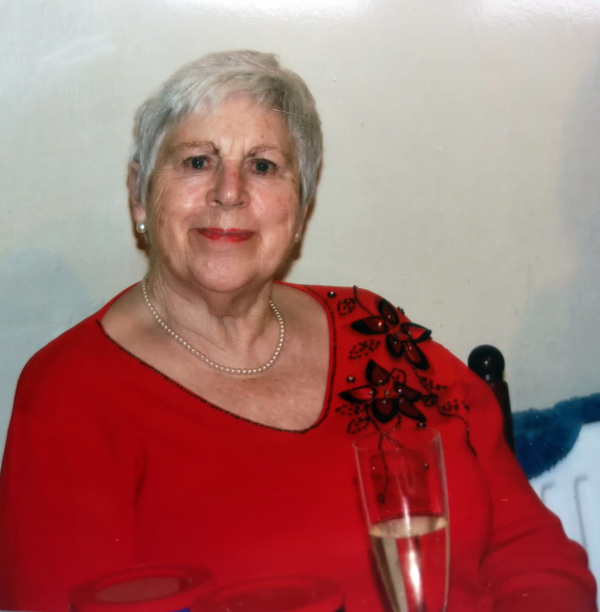In March 1937 Marlene Drew was born at Lyn Lea Nursing Home in Clifton, Brighouse. Whether she was a welcome gift is debatable as parents already in middle age with a grown-up family were unlikely to plan an addition. I was baptised at Bethel Methodist Chapel in Brighouse and given the name Marlene after the film star Marlene Dietrich, who was popular at the time. I am the only one of my siblings who is a true Brighusser.

Bethel Methodist Church - This was where Marlene was Christened in 1937.
My dad, Richard Tyrell Drew (Dick), was a flour miller, originally from York, as were the rest of my family. Dad moved to Brighouse when work was scarce in the early 1930s. The last flour mill closed in York but he found a job at Thomas Sugden and Sons’ flour mill in Brighouse. Before the rest of the family could join him he lived in lodgings on Rastrick Common. Dad knew nobody at first but he was a friendly chap who attended a lot of funerals of people he didn’t know because the funeral receptions usually provided a good tea! He recalled ‘they buried him wi’ham’ – a ham salad tea was seen as a respectable post-funeral meal.
In their early Brighouse years, my family lived in Rastrick and Brookfoot before moving to Marion Street at Waring Green. Brighouse was a collection of neighbourhoods each with their own shops (there were Co-ops and fish and chip shops everywhere) schools, churches, chapels and pubs. Our street ran from Rayner Road in the north to Thornhill Briggs Lane in the south and comprised rows of small terraced houses, some of them back to back with passages from the street giving access to the rear. In 1941, aged four, I started at St Andrew’s Infants School on Garden Road. This was during the early days of the Second World War when my two brothers were away fighting for King and Country. My sister Dolly lived two doors away in Marion Street but her husband was fighting in Italy so much of her time was spent at our house.

Marion Street, Waring Green
Aged eight I moved to St Andrew’s Junior School on Thornhill Briggs Lane. This was an old school with a sloping playground and outdoor toilets. There was no playing field, dining hall or any other facilities. We walked in crocodile fashion up the street to Waring Green Community Centre each day where pre-cooked dinners were served. Lots of cabbage and potatoes with bits of meat of some kind, milk puddings (tapioca and barley kernels) which we wolfed down whether we liked them or not. Occasionally we received ‘treats’ of cocoa powder mixed with sugar and dried milk, courtesy of the USA. We were supposed to take the small paper cones home but they never got any further than the school door. Bright red shiny apples were sent to us from Canada.

Waring Green Community Centre in 1986. Little has changed since Marlene attended here for her school dinners.
Despite the lack of amenities at school, we were never short of places to play. The ‘Rec’ at Lane Head, Wellholme Park, ‘Up Thornhills’ and down ‘The Valley’, all green spaces with endless possibilities for adventure and we made the most of them, playing out until it got dark or when our empty stomachs called us home. School classes were large as there was a shortage of teachers, but, regardless of the shortcomings, it was a good school which turned out well-educated children most of whom passed their eleven plus exams and moved on to the grammar schools. I was one of the fortunate ones and in 1948 I became a proud pupil of Brighouse Girls’ Grammar School.
Tragically my mother died of cancer in 1946 when I was nine. My two brothers were still abroad serving in the Army and didn’t get to say goodbye to their beloved mother. After a short period of mourning, Dad married a widow from York who became my step-mother. Life during the war years was hard for many people and I often think that medals should have been handed out to the housewives who kept their families fed during that period of severe rationing with long queues and huge shortages. I remember being scared during the blackouts when I imagined all kinds of horrors lurking in the passageways in our street. We rarely went out in the dark, especially when the ‘smog’ blocked out what little light there was but we enjoyed long evenings in the summer when the Government introduced Double Summer Time to help the farmers. Although we had a brick-built air-raid shelter in our street, Brighouse was fortunate in being spared the horrors of bombing common to large cities in many parts of the country. The three cinemas in Brighouse, the Ritz, Albert and Savoy, did good business and were a huge morale booster and women danced ‘bust to bust’ with each other at the Astoria Ballroom on Saturdays as men were in short supply.
The Astoria Ballroom was a popular venue for Brighouse teenagers. When it closed it became Tommy Joy's cycle and pram shop. Today, having been demolished the site is part of Wilkinson's carpark in Briggate.
My family managed to have a week’s holiday each year. The Flour Mill worked a three-shift system throughout the war. The only day they closed, other than the annual holiday, Rush Week, was when the mill was fumigated to clear it of pests – mice, rats, weevils and even stray cats. Men dressed like Ghostbusters sealed the mill and made sure we kept well out of the way. Our week’s holiday was always spent in Scarborough. We queued up at Brighouse station, kids clutching treasured buckets and spades. The Scarborough contingent waited excitably on one platform whilst the Blackpool and Morecambe lot waited on the opposite side. We climbed aboard the huge spitting steam trains often to sit on our suitcases as the trains were always full, usually of servicemen fast asleep.
When the end of the war was declared we celebrated by dancing and cheering in a crowded Thornton Square outside the Town Hall and jumped up and down in excitement around a huge bonfire built by the Council on the Rec at Lane Head, but it was some time before my brothers were able to come home and a long time before life became easier as shortages lasted well into the 1950s.
In 1948 when I was eleven, my Dad was mill foreman so Sugden’s offered him the chance to move to Brook Cottage on Mill Royd Street, right next to the Flour Mill. It backed onto the mill yard but fronted onto Mill Royd Street, next to the mill’s offices but a separate building then. The house hadn’t been lived in previously but was used as the Home Guard’s Mess Room during the war. My dad was a sergeant in the Home Guard as he’d served in the First World War and was considered to know what he was doing!
The property was badly affected by the severe floods of 1946 and required new floors, skirting boards etc. and a lot of modernisation. Those floods had affected much of the central part of the town between the canal and the river and Mill Royd Street stood smack in the middle. Dad told me that the only way to gain access into the mill then was by rowing boat and a mark was made on the mill wall showing the depth of the water, which was well over 6ft deep.

The 1946 floods in Briggate, when the best and probably only form of transport was the rowing boat.
Dad decided we would move to Brook Cottage as it was convenient for him and my step-mother, who worked at a factory on Mill Royd Street. I wasn’t sure as I didn’t want to leave Marion Street and Waring Green where my friends were and where I’d always lived but I had no say in the matter so to Mill Royd Street we went. I didn’t like living in that part of the town as it was basically an industrial area. There were a couple of old single-storey cottages at the bottom of the street opening onto Briggate and some rows of houses on the other side of Briggate, the main street leading from the Town Hall Square, over the canal and to the bridge crossing the River Calder to Rastrick. We had no neighbours on Mill Royd Street. The bottom end of the street joined Briggate and the top end was on Huddersfield Road. In between was a mixture of mills and factories.
Next door to our house was Sugden’s Provender works, which manufactured animal foods and next to them was Mellor’s Works, where they made mustards, mint and horseradish sauces. Directly opposite our house was the blacksmith’s forge, a side road leading to the grain warehouse alongside the canal, and the municipal swimming baths. At the top of the street was the town’s Mortuary and a space opening onto the canal where a mill once stood which had burned down in the past. There were no gardens or greenery, apart from a few weeds and no friendly neighbours to help each other out as was the case in Marion Street. It was a bleak environment but it was convenient for my dad and step-mother but far too convenient for Dad as it turned out as a constant stream of flour mill workers turned up at our back door at all times of day and night wanting him for one reason or another.
Dad was bald from an early age and always wore a trilby hat. His working ‘uniform’ was a brown suit covered by a white overall plus his brown trilby hat. During his time spent in the mill, it was covered in fine flour dust which got wet when he crossed the mill yard in the rain. After a period of time, his hat turned into a ‘crust’. He never changed it. He was the original Mr Pastry!
Just a few minutes away on Briggate stood the Black Swan pub where my dad went on Sunday lunchtimes for his gill of beer. On the opposite side, just before the Assembly Rooms and Masonic Hall, was the old Bow Window – a very small shop down a few steps from the street where a large cauldron of mushy peas bubbled away. Customers who had money could buy a bowl of peas and a sausage but us kids, if we had a penny or two, could have half a teacake dipped in the pea juice – it was delicious. The Bow Window was a local institution, especially popular with people coming past from the swimming baths. We kids were always hungry but especially so when only half dry and cold on our way back to school.

The Girls’ Grammar School at the top of Parsonage Lane was only a 10-minute walk from home. The town’s shops, bus station and market were all in close proximity. So like it or not, Mill Royd Street was my home until 1957 when we set up our first married home at Thornhill Briggs. Dad retired from Sugdens in 1959 and went back to live in York. I wasn’t sorry to leave Brook Cottage but I acknowledge it was an important part of my growing up years.
Many Brighouse residents will remember when the new grain silos were erected alongside the canal in 1959. We’d moved from Mill Royd Street then so they didn’t play a part in my early years as had the old original wooden silo alongside the canal. The grain, much of which came from Canada and Australia during and in the post-war years, was transported by canal barge from Goole to Brighouse and unloaded on the wharf into Sugden’s grain stores. Dad had to check the loads and I was always intrigued by his pockets full of monkey nuts (peanuts still in their shells) which were amongst the grain. Where had they come from I wonder? The grain was then loaded into a high sided cart and carried over to the flour mill pulled by a very large heavy horse. The street was paved with stone sets so the clip, clop, of the horse’s hooves was a sound I lived with as backwards and forwards went the horse to keep the mill supplied. There were two horses stabled at the side of the mill yard. I loved to go and see them and talk to the carter who looked after them but they scared me a bit as they were so big. Later on during our years at Brook Cottage, a conveyor belt was erected from the grain warehouse directly into the mill. It ran over the street and within feet of the roof of our house. It made a dreadful scraping clanking noise which was difficult to live with. I suppose we just got used to it but it was goodbye to the lovely horses and the old orange coloured cart; the end of an era. We could not have imagined the enormously tall space age silos which came along in 1959.
My years at the Grammar School were amongst the happiest of my life. The Girls’ Grammar School was an excellent school where we were privileged to receive a first-class, all-round education. I had some lovely friends, some of whom are still my good friends to this day despite them living in various parts of the country. I could have worked harder at school but my head was filled with other things – acting in particular, both as an enthusiastic member of the Brighouse Children’s Theatre, a wonderful organisation which did much for the young people of Brighouse and in plays performed at school. Despite the distractions, I managed to gain several GC O levels but I was heartbroken when I left school at 16 as I longed to go onto higher education. Dad was of the ‘old school’ believing it was a waste of time educating a girl any longer than necessary as she would only get married and have kids. In my case, this was partially true but my excellent grammar school education served me in good stead for the rest of my life and helped me to some success in my later years.
My first job after leaving school was at the Head Office of the Halifax Building Society in Halifax. Every year they took on a number of that year’s school leavers, mostly from the local grammar schools, and I soon made friends with girls and boys from Sowerby Bridge, Cleckheaton and the Halifax district. The work was mind-numbingly boring, mostly consisting of filing away numbered mortgage files in rows of grey cabinets in a huge filing department. But one life-changing event there marked my future. A young man was working on top of a metal racking being erected for yet more files. He was covered in grease and work dust and I really looked down my nose when he spoke to me. Little did I suspect that he would become my husband and we would be together for more than 60 years. Arthur Sharkey, an apprentice sheet metal worker, was one of my earliest boyfriends, but the one who lasted!!
I decided to find a job nearer home so moved to Ambassador Radio and Television Company in Brighouse, but I wasn’t there long before a job became available at the newly opened Kosset Carpets factory at Brookfoot. I could walk there along the canal bank from Mill Royd Street and the company paid good salaries, the staff were friendly and helpful and I loved it there. In the summer of 1956 Arthur ‘joined up’. It was in the days of National Service. He applied to join the Parachute Regiment and after a few months of very arduous training, he gained his red beret and became a ‘Para’ for three years. It wasn’t the most convenient time to tell him that he was to become a Daddy but all was quickly arranged, as it was in those days, and October 1956 saw us walk up the aisle at Brighouse Parish Church where I‘d attended church and Sunday School and I became Mrs Sharkey. After a wedding reception at the Black Bull Hotel in Thornton Square (ham salad again for respectability), we spent our wedding afternoon at Odsal stadium watching Bradford Northern playing Halifax, me still dressed in my posh wedding outfit. After an overnight at his parent’s house sharing the single bed he usually shared with his brother, Arthur returned to his regiment in Aldershot and I didn’t see him again for a month.

Arthur and Marlene on their wedding day.
I carried on working at Kosset Carpets as long as I could before our first son, David, was born the following May. I was still living with my parents at Brook Cottage, which was far from desirable, so we managed to rent a small cottage on Thornhill Briggs Lane and moved there in late 1957. The locals regarded Arthur rather suspiciously as he was an ‘offcumden’ . One old neighbour confronted him with “Thou arn’t frae Briggus”. ” I’m from Halifax” he replied. “I know who thou are” the old man replied. “Thou are Dick Drew dowter husband”. Connection established!

Kosset Carpets factory at Brookfoot . These premises had previously been Camm's Cotten Mill, Turner and Wainwright toffee manufacturers and the Meredith and Drew factory. Kosset was formally opened in 1956.
It was wonderful to have our own place but it was by no means luxury living. The small cottage was built into the hillside so had no ‘through light’ just a window at the front looking onto the side of the neighbouring house. The cottage had one room downstairs and a bedroom and a very small box room upstairs – no bathroom, just an outdoor toilet in a block shared by two other cottages. Even though this was 1957 the house had no electricity, no hot water, was lit by gaslight with old gas mantles, and a coal fire in a Yorkist range was the only heat source for the whole house. Despite its shortcomings, it was our home and we made the best of it. Arthur was sent abroad with his regiment to fight in the Cyprus Emergency so I was on my own with our baby son for almost a year and, thinking back, I must have been lonely – no radio or television but I got by. After a while, I had enough money saved up to pay the £17 it cost for a friend to install electricity. We also bought a small gas water heater to go above the sink. There was an ancient gas oven and I rented a radio for 2s.6p a week from Radio Rentals which provided two channels, Home Service and the Light Programme. I became an avid radio listener and am to this day.
I must admit that you get what you pay for, as our initial rent for the house was 10 shillings a month (50p) and it never increased so we couldn’t really complain. Our daughter was born at the end of 1959 and shortly afterwards Arthur was demobbed and returned to work as a sheet metal worker. We stayed in our first house for more than two years before moving to a bigger house on the next street, Croft Place. No electricity there either but we soon had that sorted. There was plenty of work in Arthur’s trade-in Brighouse and he was never unemployed. The love of his life was Rugby League, which he’d played since school days. He played for several local amateur teams and in 1960 signed for Bradford Northern where he played in their second team for a couple of seasons. In late 1961 our second son was born. Like me, Graham is a true Brigusser as he was born in our home on Croft Place in Brighouse, his older brother and sister being born in hospitals in Halifax and in Huddersfield.
Arthur never settled properly in Civvy Street after his time in the Army. He decided he needed a change so he applied to become a Police Officer with the understanding that if he failed he would re-join the Army. Fortunately, the police force accepted him and he became a Probationary Police Constable in the West Riding Police Force stationed in Brighouse. As he already knew many people in the town and was well known in most of the pubs, it was a bit like poacher turned gamekeeper and he had many memorable occasions in those early days. His tales of various colourful encounters could fill the pages of a book but my life didn’t change much as we still lived in the same house in Croft Place. Police pay was poor in those days, much less than he earned as a sheet metal worker, so we struggled to make ends meet but I was very proud to be married to a policeman. It seemed to me a real step up the social ladder!!!!

Brighouse Police Station during Arthur's time as Probationer Constable during the 1950s. This was on Police Street which during the 1960s was renamed to Lawson Road.
The West Riding Police Force was a county force that covered a very large area in the west of Yorkshire, spreading in the south below Doncaster to Sedbergh in the north, which is now in Cumbria. In January of 1964, I discovered I was expecting another child so we really needed a house with better facilities for raising a family of four children. Arthur was offered a transfer to Hebden Bridge and our third son, Jonathan, was born the following June in our new home in the countryside below the village of Heptonstall in Hebden Bridge. Our home was a council house rented by the Police but it had a bathroom and indoor toilet, and even a fridge! Such luxury. Our house was surrounded by woods and fields, a wonderful environment.
That was the start of our nomadic life with the West Riding Police Force. Over the years we moved several times, to Copmanthorpe near York, Brierley near Barnsley and finally to Keighley. Arthur had many adventures as a policeman during those years with wonderful tales to tell. He never regretted his seven years as a policeman. He played a lot of rugby for the Force, cricket as well and some football. We made good friends and had many memorable times. I coped as best as I could with the various house moves and our family became confident and quick to adapt to their new schools and friendships. I started work when the children were at school and financially life became easier. In 1970 Arthur resigned from the Force and we became licensees of a pub in Bingley
It’s true to say that my early childhood and growing up years in Brighouse formed the basic values of my life and I have much to thank them for. When I go back to Brighouse to visit my niece nowadays I feel that although times have changed the town in many ways – my old schools are gone, new roads cutting across the town, the Flour Mill closed, cinemas gone and my old neighbourhood simply car parks - there is still an essence of the old town. The railway station is open again, new restaurants and bars open, new houses and estates dotting the area, people are friendly and I am still proud to tell those who ask “I’m from Brighouse”.
Marlene Sharkey
April 2021





















